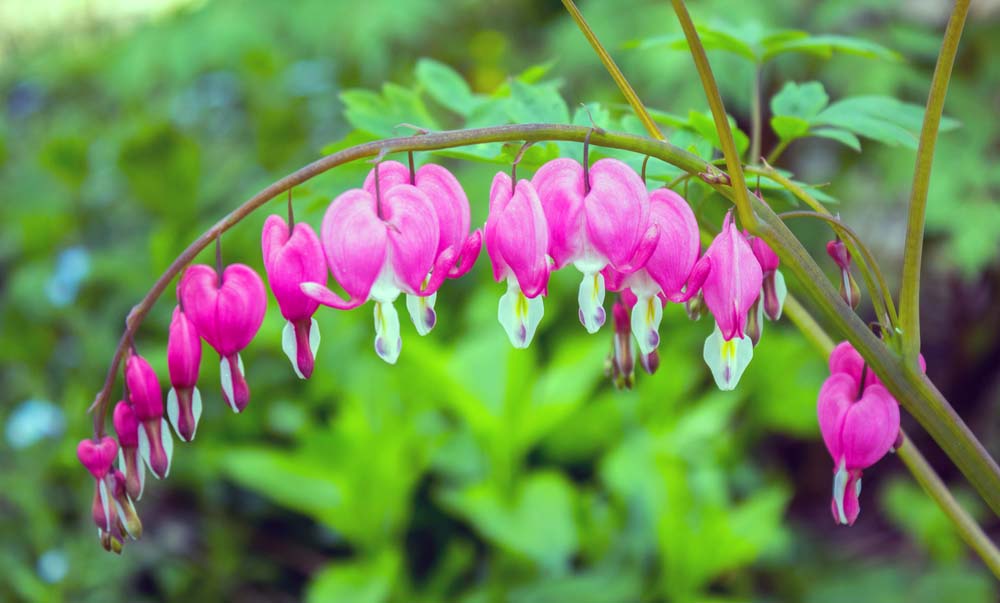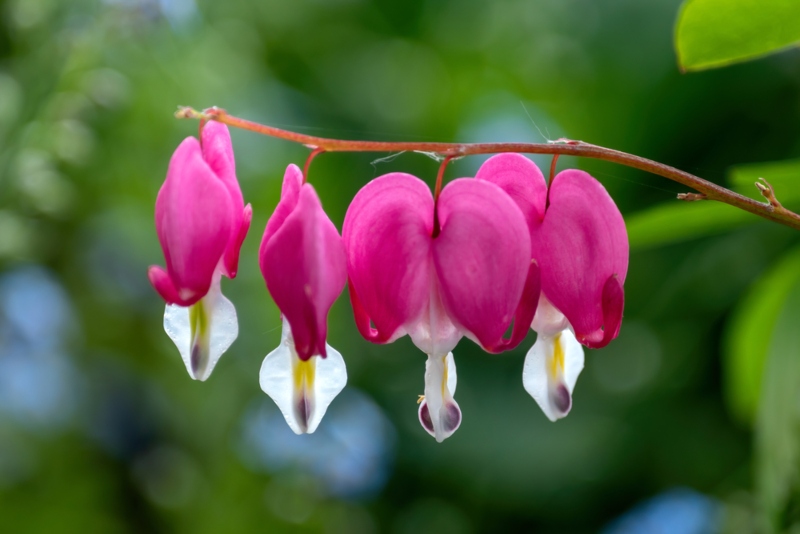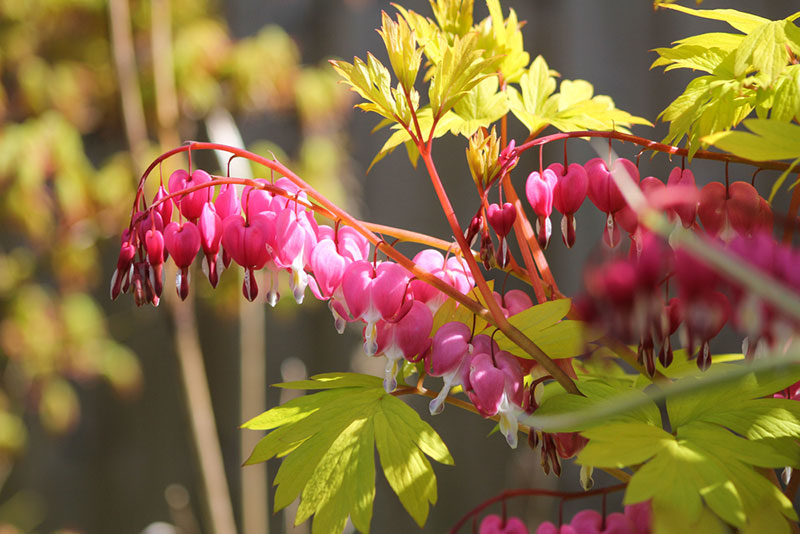
Bleeding-heart (Lamprocampos spectabilis, formerly Dicentra spectabilis) is an old-fashioned favorite in the shade garden. Many gardeners have fond memories of the pink, heart-shaped flowers with their white teardrops and ferny foliage in their grandmother’s garden.
Reliable and undemanding in the right place, Bleeding-heart gives a burst of pink and green in spring and early summer, then yields to later season plants as it goes dormant until the next year. Well-established plantings can last for many years.
Here’s the information you need to make Bleeding-hearts a treasured part of your garden.
BOTANICAL DETAILS
Bleeding-heart is an herbaceous perennial related to poppies and buttercups. It is native to Siberia, northern China, Korea, and Japan, and is related to several similar native North American wildflowers, such as Dutchman’s Breeches and Fringed Bleeding-Heart.
The species name, “spectabilis,” means showy or spectacular. Arching flower stalks emerge in the spring and bloom in single file, from base to tip. Flowers are usually some shade of pink but there are white varieties. Breeders have crossed the domestic plant with its wild relatives, creating attractive hybrids called fern leaf Bleeding-hearts.
Bleeding-heart grows in clumps from tubers, similar to peonies. Leaves may spread up to three feet and reach about the same height. Clumps will grow gradually larger but will not invade other areas.
As with many spring-flowering plants, Bleeding-heart has its show, then departs. Foliage naturally turns yellow in mid-summer and dies back as the plant goes dormant. Shade-loving ferns and hostas, which continue to grow over the summer, will cover the space. Bleeding-hearts are ideal for woodland gardens and shady borders.

GROWING REQUIREMENTS
Climate and sun: Bleeding-heart is hardy from zone 2 to 9. In the south, it needs a shady spot but in cooler northern areas it may tolerate full sun. Typically it prefers part shade to full shade. Protect from wind, which may damage the plant.
Soil: Well-drained soil with plenty of organic matter works best. Fast-drying soil will force the plant into early dormancy unless it receives extra water. Soggy soil will cause root rot. Neutral to slightly alkaline pH is best, but Bleeding-heart can grow under conifers. Mulch helps retain moisture and keeps the soil cool.
Maintenance: Bleeding-heart needs little care beyond the basic chores of weeding, protection from trampling, and fall cleanup. Spring dressing with compost will keep the soil fertile and the plant vigorous. Spent flower stalks can be removed unless you want to save the seeds. The leaves continue to produce food for next year as long as they are green. Don’t cut them down until they are thoroughly yellow. Marking the spot with a plant label will keep you from accidentally trying to plant something else over the dormant clump.
PESTS AND DISEASES
Bleeding-heart is usually a trouble-free plant. Deer and rabbits ignore it. Occasionally slugs and snails may damage young foliage and require treatment with slug bait.
Here are some other potential problems:
- Yellow leaves before midsummer may indicate too much water leading to root rot, not enough water in an exposed location, too much heat or sun, or soil pH that is too high. Peat moss or sulfur can be applied to adjust the pH. One variety, Gold Heart, has naturally yellow foliage.
- Aphids are small, green, flightless insects that cluster on tender foliage and suck plant juices. They can be washed off with spray from a hose or sprayed with insecticidal soap.
- Downy mildew forms a white powder on the leaves. It is unsightly but rarely damaging. It can be controlled by improving air circulation or spraying with a fungicide.
- Other fungal diseases include verticillium wilt, fusarium wilt, and stem rot. Verticillium wilt makes the leaves wilt. Fusarium wilt turns the lower leaves yellow, and stem rot is a slimy fungus that attacks the stems. None of them are curable. Dig out the affected plant and destroy it.
PROPAGATION AND PLANTING
In a good location and without deadheading of spent flower stalks, Bleeding-heart may reseed itself and the seedlings can be transplanted. Seeds to be grown in pots must be chilled for several weeks before being planted in soil. Young plants may not flower for several years.
Other than natural seedlings, the easiest way to get new Bleeding-heart plants is to dig up an existing plant and divide it. This should be done in spring before new growth starts or in fall after it has gone dormant. Individual tubers should have one or two eyes.
Nurseries may sell plants in containers, as bare roots, or bagged tubers. Container plants can go in the ground any time, although plants may need extra attention during hot, dry weather. Bare root plants are best planted in the spring, and tubers can be planted in spring or fall. Work some compost into the soil first. Plant tubers with the eyes on top, about 1 inch deep. Water and add mulch. Since Bleeding-heart foliage spreads, allow two to three feet between plants. If desired, fill in with shade-loving annuals while the plants establish themselves.





